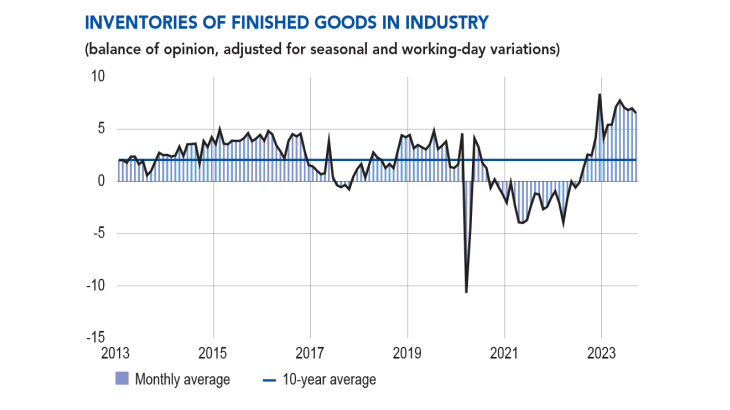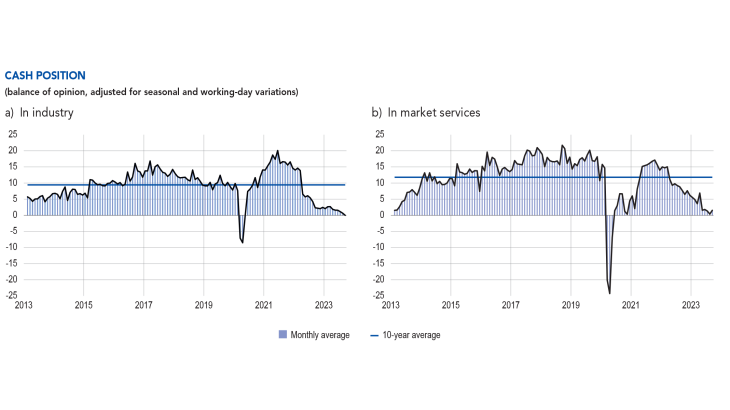- Home
- Publications et statistiques
- Publications
- Monthly Business Survey – Start of Octob...
The Banque de France publishes a range of monthly and quarterly economic surveys that provide a snapshot of the French economy in the form of business climate indicators and short-term forecasts.
According to the business leaders surveyed (approximately 8,500 companies and establishments questioned between 27 September and 4 October), activity was relatively stable in industry in September and rose in market services and in the finishing works sector of construction. In October, business leaders expect activity to improve in industry and services, and to stabilise in construction. Order books continued to weaken in industry and construction.
Supply difficulties stabilised at low levels in the building sector (9% of companies reported such difficulties in September, unchanged from August) and in industry (17%, unchanged from August). Business leaders reported a further sharp fall in raw material prices, while finished goods prices stabilised. In the three main sectors, the share of companies that increased their prices in the previous month remained low, at close to pre-Covid levels. In industry, 6% of business leaders cut their prices in September, while 7% increased them.
Recruitment difficulties eased again in September, but remained high (48%, after 50% in August).
The cash position continued to be weak in industry and services.
Based on the results of the survey, together with other indicators, GDP is expected to tick up slightly by 0.1% in the third quarter of 2023, following the surprise increase of 0.5% in the second quarter.
1. In September, activity was relatively stable in industry and rose in market services and in the finishing works sector of construction
In September, activity was virtually stable in industry, undershooting business leaders’ expectations the previous month. However, activity strengthened in pharmaceuticals, electrical equipment, machinery and equipment, and to a greater extent in aeronauticals. Conversely, it fell in wood‑paper‑printing, the agri‑food sector and other industrial goods
Year‑on‑year, the capacity utilisation rate (CUR) has fallen significantly overall, from 80% in August 2022 to 76% in September 2023. This decline is mainly due to production developments in the rubber and plastic products, other industrial goods, wood‑paper‑printing, and automotive sectors.
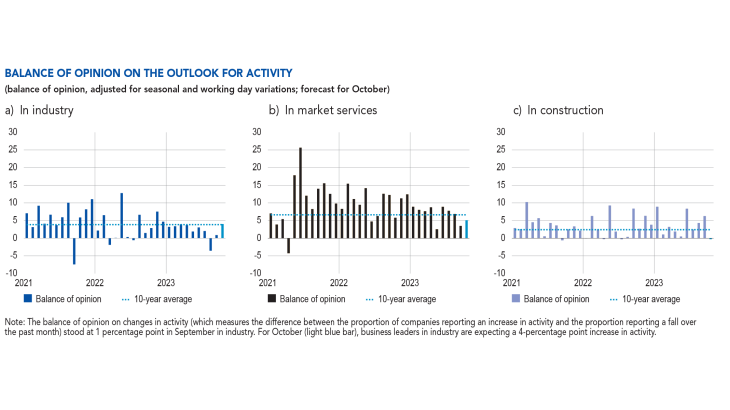
Inventories of finished goods remained high in September, with contrasting trends across sectors. In chemicals, computer, electronic and optical products and the automotive sector, inventories grew strongly. In contrast, they fell in wearing apparel, textiles and footwear.
In market services, the slowdown predicted last month by business leaders is taking hold with activity rising only slightly. Among business services, management consultancy, architecture and engineering, advertising and market research, and cleaning activities performed well. Services to individuals – accommodation, food and car rental services – picked up significantly, driven by a number of events (Rugby World Cup, boat shows, Fashion Week, resumption of seminars) and by weather conducive to tourism. Temporary work fell sharply in September, affected in particular by the downturn in the structural works sector; by contrast, the aeronautical and automotive industries were the two main sectors to recruit temporary staff.
In construction, activity in the finishing works sector grew, while there was little change in the structural sector.
The balance of opinion on the cash position deteriorated again in industry, driven down by the wood‑paper‑printing sector and the wearing apparel‑textiles‑footwear sector; it improved slightly in market services. It nevertheless remained well below its long‑term average.
2. In October, business leaders expect activity to rise in industry and services, but to decline in construction
Business leaders in industry are expecting a slight upturn in activity in October. This improvement should be seen in the agri‑food, chemicals and computer, electronic and optical products sectors. The wood‑paper‑printing sector, by contrast, is expected to decline.
In services, activity is expected to grow further. Like in September, management consultancy and architecture and engineering activities are expected to perform well. Conversely, temporary work is expected to shrink again.
Lastly, in construction, there is a marked disparity between the finishing works sector, where business leaders anticipate a slight increase in activity, and the structural works sector, which is likely to see a sharp drop.
The balance of opinion on the state of order books in industry deteriorated again in September for most sectors, particularly the automotive sector, due to a slowdown in foreign demand from China and the United States. The level of order books is considered to be particularly low in the wood‑paper‑printing, chemicals, rubber, plastics and agri‑food industries.
In construction, order books shrank significantly again in the structural works sector, where they are considered to be at their lowest level since 2015, particularly in the construction of single‑family homes and masonry work; by contrast, public‑sector orders (e.g. for the refurbishment of social housing) remained buoyant. In September, this fall in order books also affected the finishing works sector, for electrical installations, joinery and floor coverings: the drop in the volume of transactions in existing dwellings, as well as the lower turnover of tenants, is tending to weigh on renovation work. Business leaders in the finishing works sector report very poor visibility beyond the end of the year
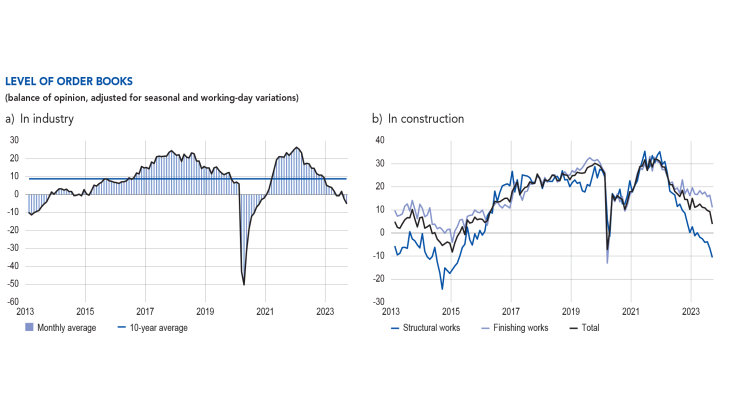
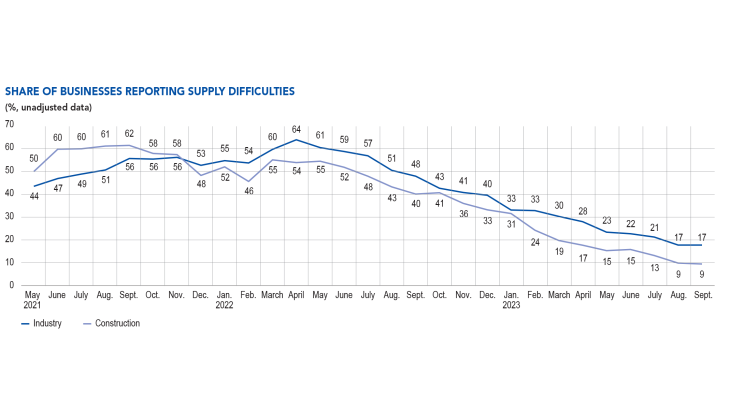
3. Supply difficulties remain low; selling prices continue to moderate
In September, supply difficulties stabilised at low levels in industry (17%, as in August) and construction (9%, as in August). In industry, the balance of opinion on raw material prices suggests a further fall. The balance of opinion on finished goods prices remained stable.
More specifically, 7% of business leaders in industry reported that they had increased their selling prices in September, compared with 29% in September 2022. Moreover, 6% of business leaders in industry reported lowering their selling prices in September, in line with the easing of raw material prices; by comparison, this proportion was around 3% during the pre‑Covid period (2017‑2019), and had fallen to almost 1% a year ago. Decreases in finished goods prices were most common in the wood‑paper‑printing, chemicals and metal and metal products manufacturing sectors.
In the agri‑food sector, just as many business leaders are now reporting reducing prices as increasing them (7%). By comparison, in September 2022, only 2% of business leaders reported cutting prices, and 43% raised them.
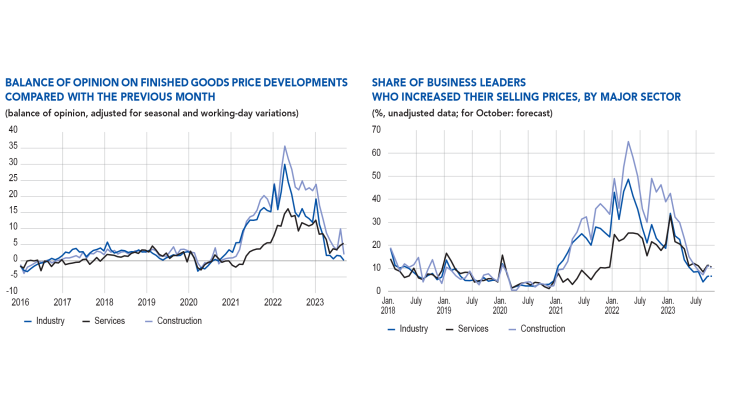
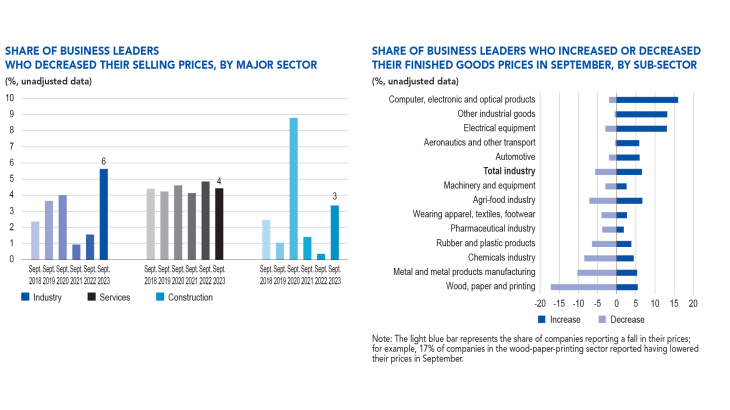
In construction, the balance of opinion on quote prices slowed sharply. 11% of companies increased their prices in September (compared with 49% in September 2022), while 3% of companies reported price cuts, compared with an average of less than 1% between mid‑2021 and the end of 2022.
In services, the share of companies reporting a rise in prices was 11%, compared with 21% a year ago. Price rises were most marked in the accommodation and car rental sectors.
The share of business leaders planning to raise prices in October is close to that seen in September, in industry (7%), market services (10%) and construction (10%). Business leaders are planning further price cuts in October in the wood‑paper‑printing sector.
Business leaders were also asked about their recruitment difficulties. They fell again in September, in all three main sectors, and now concern less than half (48%) of the companies surveyed in all sectors, compared with 50% in August.
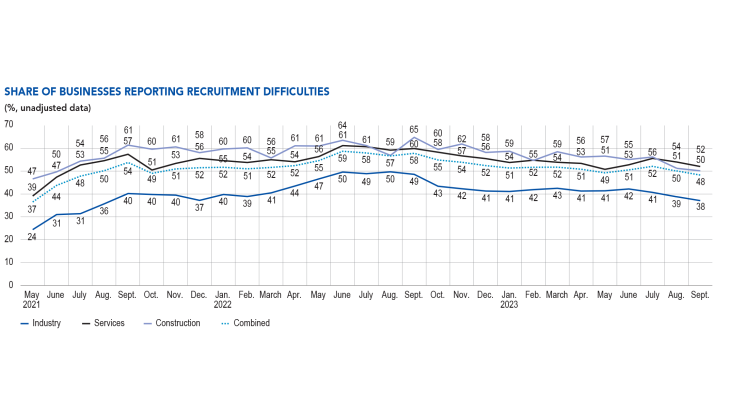
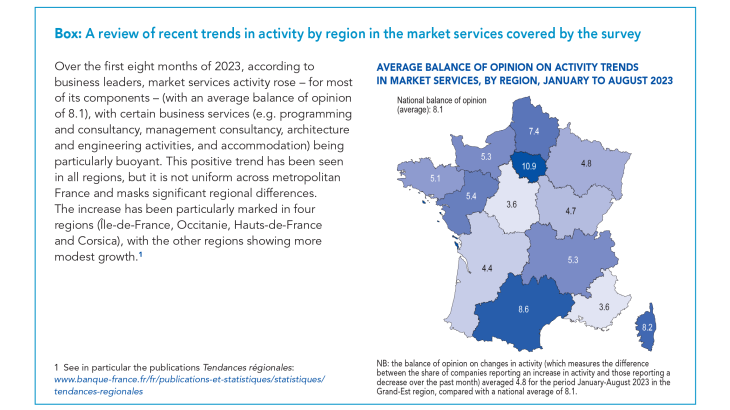
4. Our estimates suggest GDP growth of 0.1% in the third quarter
Based on granular survey data, as well as other available data (INSEE production indices and high-frequency data), we estimate that real GDP will rise slightly by 0.1% in the third quarter compared with the previous quarter. GDP growth was much higher than expected in the second quarter, driven in particular by a catch-up in transport services and energy production. Since then, economic activity appears to have slowed significantly over the summer, but continued to grow, driven by manufacturing, energy and market services.
The end of the disruption to value chains seems to have boosted value added in manufacturing, particularly in transport equipment. The energy sector continued to benefit from the positive impact of the reopening of nuclear power stations, although this is expected to fade gradually. Despite a dip in July, market services activity appears to have been resilient in the third quarter, boosted in particular by trade, accommodation, food services and information and communication services. The construction sector contracted, in line with the falls seen in the construction output index (IPI) and housing starts, although this was moderated by activity in the finishing works sector.
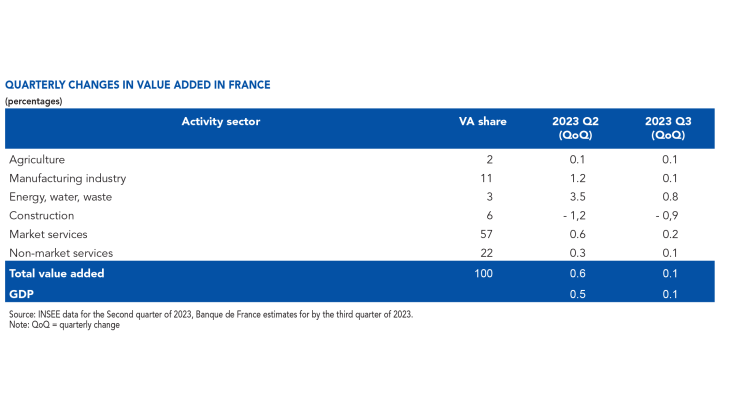
Download the paper
Updated on the 25th of July 2024
